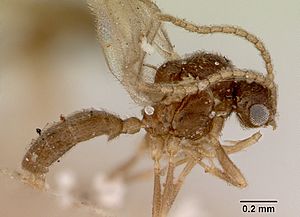Amyrmex facts for kids
Quick facts for kids Amyrmex golbachi |
|
|---|---|
 |
|
| A. golbachi male from Argentina | |
| Scientific classification |
Amyrmex golbachi is a very rare type of ant. It's the only known species in its group, called Amyrmex. So far, scientists have only found male ants of this species. They live in the Amazon basin in Brazil and in northern Argentina.
How Scientists Classify Amyrmex
Scientists group living things into categories. This helps them understand how different species are related. The group an animal belongs to is called its genus.
In 1953, a scientist named Kusnezov discovered four small male ants in Tucumán, Argentina. He decided they were a new genus, which he named Amyrmex. He also named the single species Amyrmex golbachi.
Kusnezov first placed Amyrmex in a group of ants called Dolichoderinae. However, he noticed some strange things about their wings and body shape. These features made him unsure if it truly belonged there.
For many years, not much attention was paid to Amyrmex. In 1992, another scientist, Shattuck, thought Amyrmex was actually the same as another ant genus called Forelius. This is called synonymizing.
But in 2000, Cuezzo disagreed. He looked closely at the ants' bodies and found many unique features. These features showed that Amyrmex was different from any known Forelius males. So, he brought Amyrmex back as its own genus.
Later, in 2009, scientists Ward and Brady did more detailed studies. They looked at the ants' DNA and other features. Their research showed that Amyrmex is actually closely related to a genus called Leptanilloides. This means Amyrmex belongs to a different ant group, the Dorylinae, not the Dolichoderinae. This new placement is also supported by how the ants look.
Where Amyrmex Lives
So far, Amyrmex golbachi has only been found in two main areas. These are the Amazon basin in Brazil and northern Argentina.
Scientists have not found many Amyrmex ants. The first ones found were the original four male ants (called the holotype and paratypes). A few more were found in Kusnezov's collection.
More recently, several males were found in a museum collection. Most of these were caught in special insect traps called malaise traps. These traps were set up in a lowland rainforest in Rondônia, Brazil, in 1991.
Because of where Amyrmex has been found, some scientists think it might be the same as another related genus called Asphinctanilloides. This means Amyrmex might have been named first, making it the official name.
See also
 In Spanish: Amyrmex golbachi para niños
In Spanish: Amyrmex golbachi para niños

